Abstract
In this study, we characterize the body of knowledge of groundwater remediation from 1950 to 2018 by employing scientometric techniques and CiteSpace software, based on the Science Citation Index Expanded (SCI-E) databases. The results indicate that the United States and China contributed 56.4% of the total publications and were the major powers in groundwater remediation research. In addition, the United States, Canada, and China have considerable capabilities and expertise in groundwater remediation research. Groundwater remediation research is a multidisciplinary field, covering water resources, environmental sciences and ecology, environmental sciences, and engineering, among other fields. Journals such as Environmental Science and Technology, Journal of Contaminant Hydrology, and Water Research were the major sources of cited works. The research fronts of groundwater remediation were transitioning from the pump-and-treat method to permeable reactive barriers and nanoscale zero‑valent iron particles. The combination of new persulfate ion‑activation technology and nanotechnology is receiving much attention. Based on the visualized networks, the intelligence base was verified using a variety of metrics. Through landscape portrayal and developmental trajectory identification of groundwater remediation research, this study provides insight into the characteristics of, and global trends in, groundwater remediation, which will facilitate the identification of future research directions.
1. Introduction
Groundwater is an important natural resource that supports socioeconomic development and maintains ecological balance in modern societies [1]. It provides 36% of drinking water, 42% of water for agriculture, and 24% of water for industry [2,3]. The quality of groundwater resources globally is threatened by the natural geochemical background and anthropogenic pollution [4,5]. To clean polluted groundwater and ensure the sustainability of groundwater resources, a variety of remediation technologies (e.g., pump-and-treat, biodegradation, chemical oxidation, and reduction to adsorption) have been developed and applied [6,7,8,9]. Each treatment option has associated merits and demerits, depending on remedial goals and site conditions. There are several challenges for selecting sustainable remediation technologies and designing remediation strategies today, including evolving groundwater treatment goals, complex geophysical–chemical characterization, current understanding of available technologies, contaminant mixtures, and economic considerations [8,10,11,12].
Groundwater remediation research has been reviewed from a variety of perspectives, and the extant review articles focus on technologies for the remediation of contaminated groundwater and their applications. Examples include natural attenuation processes [13], permeable reactive barriers [14], sustainability appraisal tools [15], nanoscale zero‑valent iron particles [16], and iron sulphide particles for groundwater remediation [17]. Nevertheless, little attention has been devoted to quantitative analyses of the evolution of groundwater remediation research. In short, they did not provide an overall landscape of the groundwater remediation literature. In a recent article, Zhang, Mao, Crittenden, Liu and Du [8] used social network analysis and bibliometric technology to evaluate publications related to groundwater remediation from 1995 to 2015, and the results provided valuable insight into groundwater remediation. However, they did not identify and evaluate hotspots and there is, to date, no knowledge base for groundwater remediation.
This study has used scientometric approaches to describe the development trajectory and landscape of groundwater remediation research quantitatively and systematically, and the research frontiers and emerging trends of the groundwater remediation literature were detected and identified using the visualization tool CiteSpace. The results will provide a useful reference for academics, researchers, and policy decision makers.
2. Data Acquisition and Methods
2.1. Data Acquisition
It is essential for researchers to quickly and accurately locate publications, using the search strategy and screen methods. The article retrieval source for analysis was the SCI-E databases, which are frequently used in scientific research [18]. Several topic terms, including “groundwater restoration”, “groundwater reclamation”, and “groundwater remediation”, were used to retrieve publications that contained these words in publications’ titles, keyword lists, and abstracts. These terms helped to locate the majority of groundwater-remediation-related publications. Though there may be other groundwater-remediation-related terminology, they account for a small percentage of publications and may have marginal relation to groundwater remediation research [19]. The search results have been refined or filtered by web of science categories, research areas, and document types. To do this, several categories needed to be excluded, such as (i) unrelated categories—physiology, pharmacology pharmacy, genetics heredity—(ii) document types—book chapter, data paper, proceedings abstract—and (iii) research areas—imaging science photographic technology, business economics. The search resulted in 2867 publications dated from January 1950 to September 2018. The entire records, including the titles, abstracts, keywords, and references, were then exported for subsequent analyses. Based on the frequency of groundwater remediation research over the past seven decades, we reviewed numerous studies published between 1950 and 2018 (see the Supplementary Materials).
2.2. Scientometric Analytical Methods
Scientometrics, created by Tibor Braun [20], has been defined as the “quantitative study of science and technology” [21]. As a branch of informatics, scientometrics is used to analyze patterns in scientific literature quantitatively, to understand the knowledge structure of emerging trends in a research field [22]. As a scientometric approach, CiteSpace is used to clarify multidisciplinary relationships, assess research status, map knowledge domains, reveal research frontiers, and predict emerging trends, by analyzing the bibliographic records of associated publications [23]. In the net knowledge maps generated by CiteSpace, a node represents one item (e.g., country, author, subject, term, journal, or reference), and links describe co-citations or co-occurrences between these nodes [24]. Furthermore, each node is described as a series of tree rings of different colours, with blue representing the oldest and orange the most recent [25]. A purple ring around an item indicates good centrality.
To date, CiteSpace has been employed in studies of, for example, nonpoint source pollution [26], information sciences [27], psychological science [28], and global green innovation [29]. In this study, we produced and analyzed co-occurrence networks of subject categories and countries, and co-citation networks of journals, authors, and references using CiteSpace.
3. Results and Discussion
3.1. Characteristics of Publication Output
To give an overview of research in groundwater remediation, the annual number of articles published from 1950 to 2018 (total, 2867) is shown in Figure 1. In 1950, only one article, titled “Ground-Water Pollution in Michigan”, was published [30]. Subsequently, the annual number of publications was fewer than 10 until 1990. The number of articles increased significantly after this period, from 23 in 1991 to 207 in 2016.
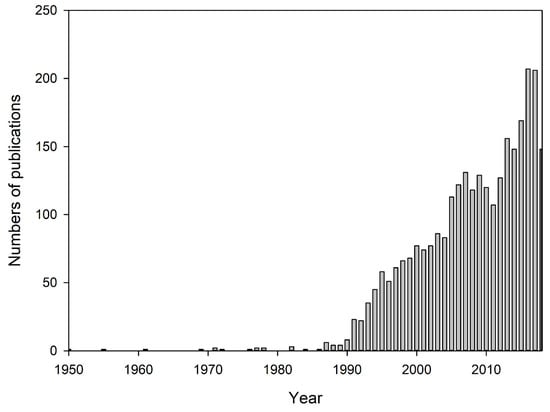
Figure 1.
Publication output performance during the period 1950–2018.
3.2. Co-Operations of Countries/Territories and Institutions
3.2.1. Co-Operation among Countries/Territories
Running CiteSpace, we obtained a countries/territories distribution with 78 nodes and 296 links (Figure 2); this map can help researchers find their colleagues elsewhere in the world and establish collaborations. Each node represents a different country or territory, and the size of the node represents the number of publications. Similarly, the lines connecting countries/territories indicate their co-operation, while the thickness of the line represents the degree of co-operation [8]. The United States (U.S.) was the hub of the co-operation network, and the leader in groundwater remediation research, in collaboration with other productive countries/territories. The discovery of hazardous waste at Love Canal in Niagara, New York, and many other places in the United States, heralded a new era in hazardous waste problems by the end of the 1970s. Subsequently, civil and environmental engineers, hydrologists, hydrogeologists, and other scientists became involved in the identification, evaluation, and remediation of groundwater-contaminated hazardous waste sites [31]. Groundwater remediation research was distributed among 78 countries/territories, and the top 10 countries/territories published 2607 articles, accounting for 90.9% of the total (Table 1). The U.S. and China published 1152 and 464 articles, respectively, ranking first and second, and accounting for 56.4% of total articles. Thus, the U.S. and China were two major research powers in groundwater remediation and far ahead of other countries/territories.
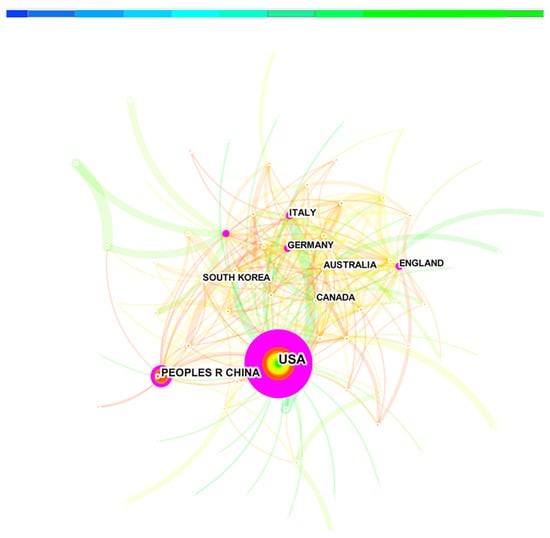
Figure 2.
Distribution of co-operation among countries/territories.

Table 1.
Distribution of 10 co-operative countries/territories and institutions.
3.2.2. Co-Operation among Institutions
Institutional co-operation was also analyzed using CiteSpace (Figure 3). The top 10 productive institutions are shown in Table 1. These 10 productive institutions worked closely with organizations in geographical proximity, e.g., the University of Waterloo and University of Regina in Canada, the University of Illinois and the University of Arizona in the U.S., and China University of Geosciences and Jilin University in China. Therefore, it is necessary to strengthen international co-operation in the future.
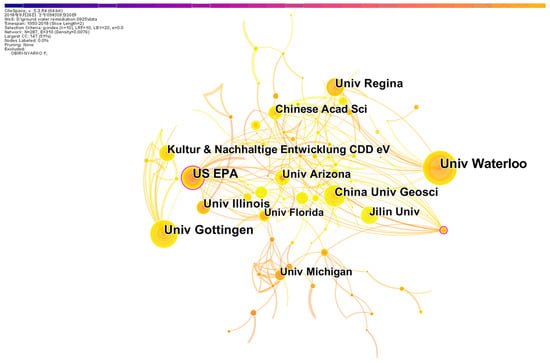
Figure 3.
Distribution of co-operation among research institutions.
The top 10 research institutions issued 455 articles, accounting for 15.9% of the total. According to Table 1 and Figure 3, the first major research echelon was led by the University of Waterloo, where hydrologists first used zero-valent iron (Fe0) to treat contaminated groundwater in situ approximately three decades ago [32,33]. Of these top 10 institutions, three were in the U.S. and three in China, confirming that the U.S., Canada, and China have considerable capabilities in groundwater remediation research, and strong expertise in research and development.
3.3. Co-Occurrence of Subject Categories
Based on co-occurrence analyses of subject category, the disciplines involved in groundwater remediation can be detected. In this study, we selected the top 30 subject categories with the largest number of reoccurrences each year for category characteristic analysis. The information on subject categories was extracted from the SCI-E databases using CiteSpace and analyzed. Figure 4 shows the co-occurrence network from 1950 to 2018, where one node represents a subject category, and the edge connecting two nodes represents the co-occurrence of two subject categories. The top three popular research categories were environmental sciences and ecology, environmental sciences, and engineering. Of the top 10 subject categories, engineering had the central position and played an important role in groundwater remediation. Material science was second, followed by water resources, and chemistry, physical. Therefore, groundwater remediation is a multidisciplinary research field, involving an extensive range of interests.
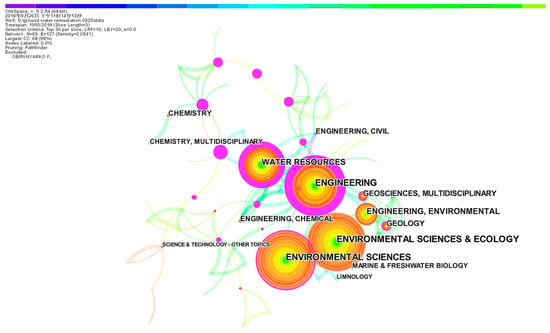
Figure 4.
Disciplines involved in the field of groundwater remediation, shown as a network of subject categories.
3.4. Journal Citation Analyses
“Core journals” usually refer to top-ranking journals with high citation frequencies. We produced a groundwater remediation journal co-citation map with 199 nodes and 1149 links, using CiteSpace software (Figure 5). The top 10 most productive journals, with >500 citations, are listed in Table 2. The total of 12,090 citations from the 10 journals accounts for 34.74% of the total citation count. Thus, the citation distribution was concentrated. In addition, these 10 journals were defined as the “core journals” in the field of groundwater remediation.
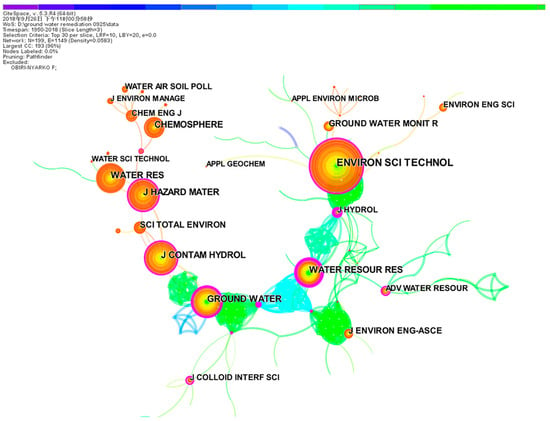
Figure 5.
Journal co-citation knowledge map.

Table 2.
Distribution of 10 “core journals” and IF in 2017.
Environmental Science and Technology and Water Research were the core journals in groundwater remediation research, with 1850 and 1204 citations, respectively (Table 2). Water Research and Environmental Science and Technology also had the highest IFs, at 7.051 and 6.653, respectively.
3.5. Author Citation Analyses
White and McCain [34] first proposed the author co-citation concept in the U.S. Author co-citation maps, which reflect the closeness of the research directions and importance of the authors, and have been widely used to assess scientific research ability and relevance. Herein, one node represents a cited author, and an author co-citation knowledge map was created using CiteSpace (Figure 6).
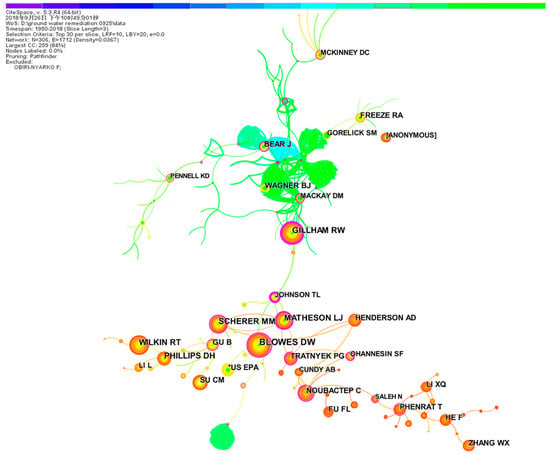
Figure 6.
Author co-citation map/the co-operation network of productive authors.
The largest node corresponded to Blowes DW, whose articles were cited 251 times; this was followed by Gillham RW (233), Wilkin RT (204), Matheson LJ (190), Scherer MM (177), Phillips DH (165), Su CM (157), and Noubactep C (145). Thus, these authors’ works had a marked impact on groundwater remediation research and development, and they represent the core research strength in the field.
As mentioned above, the first major research echelon, led by the University of Waterloo, was composed of Gillham RW, Blowes DW, and other authors, suggesting that this group had the greatest impact on groundwater remediation research.
3.6. Documents Co-Citation Analyses
The co-citation network was divided into many clusters of co-cited references in CiteSpace, so that references are closely connected within the same cluster but loosely connected among different clusters (Figure 7). The 10 major clusters are listed in Table 3 by size, which represents the number of members in each cluster. The silhouette score of a cluster reflects its quality, i.e., homogeneity or consistency. If the silhouette value of a cluster is close to 1.0, then it was homogenous [22]. All the clusters in Table 3 were highly homogeneous, as indicated by their high silhouette scores. Noun phrases from the terms (e.g., titles or abstracts) used in articles in the cluster were used to label each cluster. Labels selected by the log-likelihood ratio (LLR) test were used in subsequent discussions [35].
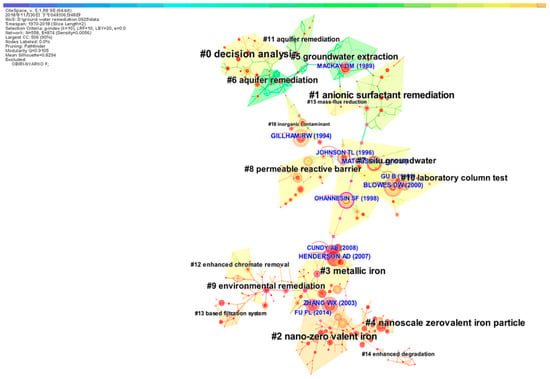
Figure 7.
The synthetic network of co-cited references.

Table 3.
Major clusters of co-cited references.
We can identify the average year of the publications in a cluster by their recentness, i.e., Cluster #6 on aquifer remediation had an average year of publication of 1985. The recently formed clusters, Clusters #2 and #3 (nano-zero‑valent iron and metallic iron, respectively), had an average year of publication of 2009 and 2008, respectively.
3.6.1. Analyses of Research Fronts
Price [36] proposed the concept of the research front, and postulated that a research front can characterize the momentary nature of a research field. Garfield [37] defined a research front as “a cluster of co-cited articles and all articles that cite the cluster”. Chen [38] defined a research front as “an emergent and transient grouping of concepts and underlying research issues”. CiteSpace shapes the network knowledge map of research fronts, with mutant terms that can be extracted from the index terms, abstracts, titles, and record indicators of the references. Specific methods include selecting a cited reference as the net node, the g-index (k = 10) as threshold willing, and the key pathfinder algorithm. We obtained 17 clusters by selecting “Find clusters” and abstracted the names of the clusters by selecting “Label clusters with indexing terms”. Figure 7 shows the net knowledge map generated.
There were 558 nodes, 874 links, and 17 clusters. Clusters #2, #3, and #4 had a high concentration of nodes with citation bursts, which echoed the fact that these were the most recently formed clusters.
If a cluster has a larger area, it has more bibliographic entries, and large clusters generally indicate main research directions, i.e., each cluster corresponds to a research front. The research fronts and major trends in groundwater extraction, in situ groundwater remediation, permeable reactive barriers, metallic iron, and nanoscale zero‑valent iron particles are shown in Figure 7 and Table 3.
3.6.2. Timeline of Research Fronts
Figure 8 shows timelines of the 17 distinct co-citation clusters and their interrelationships. All timelines run from left to right [39], show the times at which research fronts appear and disappear, and display structural information about the research front clusters [40]. Analysts can visually identify various characteristics of a cluster, such as its citation classics, historical length, citation bursts, and connection to other clusters.
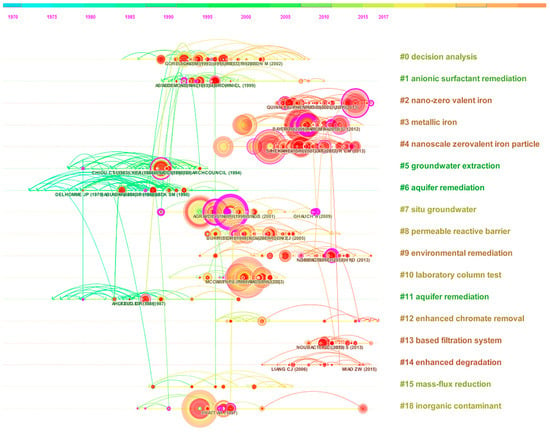
Figure 8.
Timelines of co-citation clusters. Major clusters are labelled on the right.
The following paragraphs provide an interpretation of the research fronts’ timelines. Groundwater remediation research has a long history (Figure 8). The earliest research front, “aquifer remediation”, provided basic information for subsequent research. Next, technologies to deal with contaminated groundwater were developed. The containment and/or control of contaminated groundwater can generally be accomplished using one, or a combination, of several available techniques, which can be broken down into aquifer rehabilitation, physical containment measures, and withdrawal, treatment, and use [41].
The second research front, “groundwater extraction”, began around 1979, and pump‑and‑treat as a groundwater extraction technology began at selected sites in 1982 [42], in response to groundwater pollution control and contamination remediation. Earlier pump‑and‑treat systems, which did not consider the presence of geologic heterogeneity, poor definition of initial condition in source zones, did not clean aquifers to the required level. Many of the original systems worked adequately for a period of time, but, after they were switched off, the contaminant levels at many sites reached values higher than those before remediation [31]. Subsequent to the pivotal 1989 article by Mackay [43], the research front became inactive. A number of new technologies for groundwater remediation are under development, and these may accelerate contaminant removal from the subsurface (e.g., injection of steam, surfactants) or destroy the contaminant in situ [43]. Hence, research fronts are discontinuous, and start and end abruptly when scientists move from one puzzle to the next [40].
In the 1990s, scientists and engineers had to prepare to deal with recent puzzles, which included residual oils, source zones with non-aqueous phase liquids (NAPLs), and vapours in the unsaturated zone [31]. During this period, four research fronts, “anionic surfactant remediation (1995)”, “decision analyses (1997)”, “laboratory column test (1999)”, and “in situ groundwater remediation (1999)”, were created in response to growing concern over efficient and cost-effective clean‑up solutions. Among these research fronts, “in situ groundwater remediation” was worthy of note. This research front experienced a period of stability and extends to the present. A growing number of researchers focused on the development of in situ remediation technologies, e.g., in situ chemical oxidation [ISCO]. ISCO, a type of advanced oxidation process technology, has proven useful for in situ remediation technology for the most prevalent organic contaminants in groundwater. The development of in situ remediation technologies led to the formation of three research fronts in the new century: “permeable reaction barriers (PRBs) (2002)”, “metallic iron (2008)”, and “nano zero‑valent iron (nZVI) (2009)”.
The research front, “PRB”, which dates to 1989, had a median publication date of 2002. Over the last two decades, PRBs have been emerging as an effective alternative passive in situ remediation technology. In the 1990s, research on PRBs increased considerably, which led to many new approaches for suitable reactive materials, target contaminants, and PRB design.
“nZVI” is the latest research frontier, showing rapid growth and a professional pattern. Gillham and O’Hannesin [44] discovered that halogenated aliphatic compounds in groundwater can be reduced using bulk ZVI. This characteristic of iron led to the advanced Fe-PRB, in which vertical trenches were filled with granular ZVI, placed in the flow path of the underground contaminant plumes [45,46].
A report [47] by the Chinese Academy of Sciences indicated that the third top research front in ecology and environmental sciences, entitled “Activation of persulfate for degradation of aqueous pollutants by transition metal and nanotechnology”, is receiving much global attention. The combination of persulfate ion activation technology and nanotechnology will improve the efficiency of polluted water treatment, reduce energy consumption, and promote recycling.
3.6.3. Analyses of the Intelligence Base
Chen [38] defined “the intellectual base of a research front as its citation and co-citation footprint in the scientific literature, an evolving network of scientific publications cited by research-front concepts”.
(1) Most‑Cited Articles
The most‑cited articles are generally considered landmarks, owing to their ground‑breaking contributions [22]. Cluster #7 had three of the top 10 landmark articles, and Clusters #3 and #10 each had two (Table 4). The most-cited articles in the databases were by Blowes (2000), with 154 citations, followed by Gillham (1994), with 144 citations and Matheson (1994), with 135 citations, and the most recent was a review article by Fu (2014). Interestingly, the titles of the most‑cited articles contained the terms “permeable reactive barriers”, “zero-valent iron”, “nanoscale iron particles” (Table 4), which were in accordance with the research fronts noted above.

Table 4.
The top 10 most-cited references.
Gillham and O’Hannesin [44] investigated the potential of Fe0 in the dehalogenation of ethanes, ethenes, and 14 chlorinated methanes. The results demonstrated biotic reductive dechlorination, in which iron serves as the source of electrons. In response to the rapid degradation rates, an application for in situ remediation of contaminated groundwater was proposed.
Blowes, et al. [48] was cited the most frequently. This paper reviewed the recent research progress in PRBs for the remediation of inorganic contamination of groundwater.
(2) Betweenness Centrality
The betweenness centrality measure that Freeman [49] proposed is used to give prominence to potential pivotal points in the synthesized network shifts over time. The betweenness centrality of nodes in a network is indicative of the importance of the location of the nodes. We are especially interested in the nodes located between different node groups, because they probably offer insight into emerging trends [22]. Table 5 shows 10 structurally crucial references in the network, and three of these nodes were in Cluster #3, and five in Cluster #7. These references can be identified as landmark works in the field of groundwater remediation.

Table 5.
Cited citations with the highest between centrality.
(3) Citation Bursts
A reference citation burst may indicate an emergent research front, and the citation-burst-detection algorithm of Kleinberg [50] is adapted for identifying emergent research front concepts. Table 6 lists the references that had the strongest metric of citation bursts across the entire database during the period 1950–2018. Among the articles with strong citation bursts (Table 6 and Figure 9), Mackay and Cherry [43] is worthy of note. Their article explored the reasons for the difficulty of groundwater clean-up, noted some implications, and suggested that achieving stringent health-based clean-up standards is unlikely, and the ultimate cost of clean-up is high in many cases. Thus, they suggested that site characterization and remediation have much room for improvement, by both the development of new tools and ongoing training of staff [43]. Subsequently, the development of permeable reactive barrier technology using zero-valence iron filings has proceeded from recognition, evaluation, technology conceptualization, and proof of concept, to commercialization.

Table 6.
The top five references with the strongest metric of citation bursts.
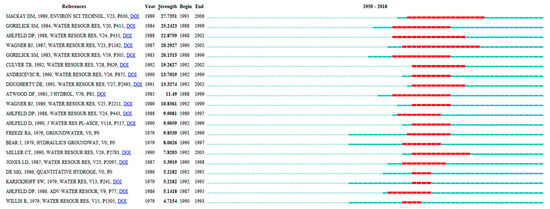
Figure 9.
The top 20 references with the strongest citation bursts.
(4) Sigma
The structural centrality and citation burstness of cited references can be measured by the Sigma metric measure, i.e., the Sigma value of a reference that is strong in both measures will be higher than that of a reference that is strong in only one of the two measures [22] (Table 7). The pioneering article by Fu, et al. [51] had the highest Sigma of 101,578.09, indicating it to be structurally indispensable in the field, due to its strong citation burst. This article reviewed the recent advances of ZVI and the progress made in groundwater remediation using ZVI technology.

Table 7.
Structurally and temporally significant references.
4. Conclusions
4.1. Summary
This study offers a comprehensive scientometric review of groundwater remediation research. There were 2867 journal articles related to this field published from 1950 to 2018, and the increasing annual number of publications suggests a continued research interest and a globally urgent need to remediate contaminated groundwater, since 1991. The U.S. and China contributed 56.4% of the publications and were the major powers in groundwater remediation research. Groundwater remediation research is a multidisciplinary research field and covers an extensive range of interests, from environmental sciences and ecology to environmental sciences, engineering, and water resources. Furthermore, journals such as Environmental Science and Technology, Water Research, and Journal of Contaminant Hydrology were the main sources of cited works in groundwater remediation research. The research fronts of groundwater remediation were transitioning from the pump-and-treat method to PRBs and nanoscale zero‑valent iron particles. The combination of persulfate ion activation technology and nanotechnology shows promise. Meanwhile, based on the visualized networks, the intelligence base was verified using a variety of metrics. Our study provides a valuable reference for researchers in the field of groundwater remediation, and others with interests in this area.
4.2. Future Outlook
(1) Development of treatment trains. Great advances have been made in the field of groundwater remediation research over recent decades. As the “One Size Fits All” remedy technology does not work effectively at most contaminated sites, the groundwater remediation technologies used are generally parts of a “treatment train”. Hence, tailored approaches and remediation techniques on a site-by-site basis are needed. In addition, research into technologies for pollution remediation of fractured bedrock aquifers, low permeability formations, and green remediation technology, is needed. Hence, these topics will remain areas of active research for many years.
(2) Optimization of groundwater remediation design under uncertainty. The technical and environmental challenges in designing optimal groundwater remediation systems are the spatial variability of natural aquifers, uncertain aquifer parameters, and complex site characteristics, which affect both the cost and efficiency of remediation. Investment in data collection and accurate site characterization may minimize uncertainty. Simultaneously, effort has been made to include uncertainty analyses in optimal groundwater remediation designs, using optimization methods and a coupled simulation–optimization approach. Owing to the complexity and inherent uncertainty of groundwater remediation technologies, the success of their field application is limited. This suggests the need to incorporate new methods and means of quantitatively analyzing uncertainty into the design of optimal groundwater remediation technologies.
(3) Development of green and sustainable remediation. Green and sustainable remediation (GSR) is a new movement in the land and groundwater remediation field that has drawn much attention globally in recent years, and it requires consideration of the environmental, economic, and social dimensions of sustainability. GSR technologies for contaminated groundwater, including biochar materials, green synthesis of engineered nanoparticles [52], sustainable PRB [53] and sustainably released long-term green remediation materials, have made rapid progress. However, case studies indicate that public participation must be improved to promote social sustainability, and region-specific factors should be considered when implementing GSR.
Supplementary Materials
Publications list for scientometric analysis (topic searched results in SCI-E database) includes title of the article, journal name, authors, year of publication, volume, page range. The following is available online at https://www.mdpi.com/1660-4601/16/20/3975/s1, Spreadsheet: Publications list.
Author Contributions
Methodology, G.F.; Q.C.; literature search and data analysis, Q.C.; W.N.; writing—Original draft, Q.C.; J.L.; writing—Review and editing, Q.C.; H.L.; supervision: J.C.
Funding
This study was funded by Shanxi Provincial Water Conservancy Science and Technology Research and Promotion Project of China, the Shanxi Provincial Natural Science Foundation of China (Grant No. 201601D102037).
Acknowledgments
The authors would like to thank Prof. Guishen Fan for his thoughtful review of a later draft.
Conflicts of Interest
The authors declare that they have no conflict of interest.
References
- Zaporozec, A. Ground-water pollution and its sources. GeoJournal 1981, 5, 457–471. [Google Scholar] [CrossRef]
- Doell, P.; Hoffmann-Dobrev, H.; Portmann, F.T.; Siebert, S. Impact of water withdrawals from groundwater and surface water on continental water storage variations. J. Geodyn. 2012, 59–60, 143–156. [Google Scholar] [CrossRef]
- Hao, A.; Zhang, Y.; Zhang, E.; Li, Z.; Yu, J.; Wang, H.; Yang, J.; Wang, Y. Review: Groundwater resources and related environmental issues in China. Hydrogeol. J. 2018, 26, 1325–1337. [Google Scholar] [CrossRef]
- Hou, D.; Li, G.; Nathanail, P. An emerging market for groundwater remediation in China: Policies, statistics, and future outlook. Front. Environ. Sci. Eng. 2018, 12, 16. [Google Scholar] [CrossRef]
- Obiri-Nyarko, F.; Grajales-Mesa, S.J.; Malina, G. An overview of permeable reactive barriers for in situ sustainable groundwater remediation. Chemosphere 2014, 111, 243–259. [Google Scholar] [CrossRef]
- Barcelona, M.J. Development and applications of groundwater remediation technologies in the USA. Hydrogeol. J. 2005, 13, 288–294. [Google Scholar] [CrossRef]
- Filler, D.M.; Reynolds, C.M.; Snape, I.; Daugulis, A.J.; Barnes, D.L.; Williams, P.J. Advances in engineered remediation for use in the Arctic and Antarctica. Polar Rec. 2006, 42, 111–120. [Google Scholar] [CrossRef]
- Zhang, S.; Mao, G.; Crittenden, J.; Liu, X.; Du, H. Groundwater remediation from the past to the future: A bibliometric analysis. Water Res. 2017, 119, 114–138. [Google Scholar] [CrossRef]
- Rugner, H.; Finkel, M.; Kaschl, A.; Bittens, M. Application of monitored natural attenuation in contaminated land management—A review and recommended approach for Europe. Environ. Sci. Policy 2006, 9, 568–576. [Google Scholar] [CrossRef]
- Hadley, P.W.; Newell, C.J. Groundwater Remediation: The Next 30 Years. Ground Water 2012, 50, 669–678. [Google Scholar] [CrossRef]
- Stroo, H.F.; Leeson, A.; Marqusee, J.A.; Johnson, P.C.; Ward, C.H.; Kavanaugh, M.C.; Sale, T.C.; Newell, C.J.; Pennell, K.D.; Lebron, C.A.; et al. Chlorinated Ethene Source Remediation: Lessons Learned. Environ. Sci. Technol. 2012, 46, 6438–6447. [Google Scholar] [CrossRef] [PubMed]
- Leeson, A.; Stroo, H.F.; Johnson, P.C. Groundwater Remediation Today and Challenges and Opportunities for the Future. Ground Water 2013, 51, 175–179. [Google Scholar] [CrossRef] [PubMed]
- Wang, S.; Mulligan, C.N. Natural attenuation processes for remediation of arsenic contaminated soils and groundwater. J. Hazard. Mater. 2006, 138, 459–470. [Google Scholar] [CrossRef] [PubMed]
- Thiruverikatachari, R.; Vigneswaran, S.; Naidu, R. Permeable reactive barrier for groundwater remediation. J. Ind. Eng. Chem. 2008, 14, 145–156. [Google Scholar] [CrossRef]
- Beames, A.; Broekx, S.; Lookman, R.; Touchant, K.; Seuntjens, P. Sustainability appraisal tools for soil and groundwater remediation: How is the choice of remediation alternative influenced by different sets of sustainability indicators and tool structures? Sci. Total Environ. 2014, 470, 954–966. [Google Scholar] [CrossRef]
- Tosco, T.; Papini, M.P.; Viggi, C.C.; Sethi, R. Nanoscale zerovalent iron particles for groundwater remediation: A review. J. Clean. Prod. 2014, 77, 10–21. [Google Scholar] [CrossRef]
- Gong, Y.; Tang, J.; Zhao, D. Application of iron sulfide particles for groundwater and soil remediation: A review. Water Res. 2016, 89, 309–320. [Google Scholar] [CrossRef]
- Wu, X.L.; Chen, X.Y.; Zhan, F.B.; Hong, S. Global research trends in landslides during 1991–2014: A bibliometric analysis. J. Landslides 2015, 12, 1215–1226. [Google Scholar] [CrossRef]
- Niu, B.B.; Loaiciga, H.A.; Wang, Z.; Zhan, F.B.; Hong, S. Twenty years of global groundwater research: A Science Citation Index Expanded-based bibliometric survey (1993–2012). J. Hydrol. 2014, 519, 966–975. [Google Scholar] [CrossRef]
- Brookes, B.C. Biblio-, Sciento-, Infor-Metrics??? What Are We Talking About? Elsevier: Amsterdam, The Netherlands, 1990. [Google Scholar]
- Hood, W.; Wilson, C. The literature of bibliometrics, scientometrics, and informetrics. Scientometrics 2001, 52, 291–304. [Google Scholar] [CrossRef]
- Chen, C.; Hu, Z.; Liu, S.; Tseng, H. Emerging trends in regenerative medicine: A scientometric analysis in CiteSpace. Expert Opin. Biol. Ther. 2012, 12, 593–608. [Google Scholar] [CrossRef]
- Song, J.; Zhang, H.; Dong, W. A review of emerging trends in global PPP research: Analysis and visualization. Scientometrics 2016, 107, 1111–1147. [Google Scholar] [CrossRef]
- Xie, P. Study of international anticancer research trends via co-word and document co-citation visualization analysis. J. Scientometr. 2015, 105, 611–622. [Google Scholar] [CrossRef]
- Liu, Z.G.; Yin, Y.M.; Liu, W.D. Visualizing the intellectual structure and evolution of innovation systems research: A bibliometric analysis. J. Scientometr. 2015, 103, 135–158. [Google Scholar] [CrossRef]
- Xiang, C.; Wang, Y.; Liu, H. A scientometrics review on nonpoint source pollution research. Ecol. Eng. 2017, 99, 400–408. [Google Scholar] [CrossRef]
- Yu, D.; Xu, Z.; Pedrycz, W.; Wang, W. Information Sciences 1968–2016: A retrospective analysis with text mining and bibliometric. Inf. Sci. 2017, 418–419, 619–634. [Google Scholar] [CrossRef]
- Pan, X.-J.; Zhao, H.-N.; Li, M.-M. Information visualization analysis on Advances in Psychological Science: 1983–2014. Chin. Nurs. Res. 2017, 4, 124–129. [Google Scholar] [CrossRef]
- Yin, J.; Gong, L.; Wang, S. Large-scale assessment of global green innovation research trends from 1981 to 2016: A bibliometric study. J. Clean. Prod. 2016, 197, 827–841. [Google Scholar] [CrossRef]
- Billings, N. Ground-water pollution in michigan. Sew. Ind. Wastes 1950, 22, 1596–1600. [Google Scholar]
- Bedient, P.B.; Rifai, H.S.; Newell, C.J. Ground Water Contamination: Transport and Remediation, 2nd ed.; Prentice Hall PTR: London, UK, 1999. [Google Scholar]
- Reynolds, G.W.; Hoff, J.T.; Glllham, R.W. Sampling Bias Caused by Materials Used To Monitor Halocarbons in Groundwater. Environ. Sci. Technol. 1990, 24, 135–142. [Google Scholar] [CrossRef]
- Myrand, D.; Gillham, R.W.; Sudicky, E.A.; O’Hannesi, S.F.; Johnson, R.L. Diffusion of volatile organic compounds in natural clay deposits: Laboratory tests. J. Contam. Hydrol. 1992, 10, 159–172. [Google Scholar] [CrossRef]
- White, H.D.; McCain, K.W. Visualizing a Discipline: An Author Co-Citation Analysis of Information Science, 1972–1995. J. Am. Soc. Inf. Sci. 1998, 49, 327–355. [Google Scholar]
- Chen, C.; Ibekwe-SanJuan, F.; Hou, J. The Structure and Dynamics of Co-Citation Clusters: A Multiple-Perspective Co-Citation Analysis. J. Am. Soc. Inf. Sci. Technol. 2010, 61, 1386–1409. [Google Scholar] [CrossRef]
- Price, D.D. Networks of scientific papers. Sci. Total Environ. 1965, 149, 510–515. [Google Scholar]
- Garfield, E. Scientography: Mapping the Tracks of Science. Current contents: Social & behavioural sciences. Curr. Contents Soc. Behav. Sci. 1994, 7, 5–10. [Google Scholar]
- Chen, C. CiteSpace II: Detecting and Visualizing Emerging Trends and Transient Patterns in Scientific Literature. J. Am. Soc. Inf. Sci. Technol. 2006, 57, 359–377. [Google Scholar] [CrossRef]
- Zhang, J.; Chen, C.; Li, J. Visualizing the Intellectual Structure with Paper-Reference Matrices. IEEE Trans. Vis. Comput. Graph. 2009, 15, 1153–1160. [Google Scholar] [CrossRef]
- Morris, S.A.; Yen, G.; Wu, Z.; Asnake, B. Timeline visualization of research fronts. J. Am. Soc. Inf. Sci. Technol. 2003, 54, 413–422. [Google Scholar] [CrossRef]
- Lehr, J.H.; Nielsen, D.M. Aquifer restoration and ground-water rehabilitation. Groundwater 1982, 20, 650–656. [Google Scholar] [CrossRef]
- Bartow, G.; Davenport, C. Pump-and-Treat accomplishments—A review of the effectiveness of ground-water remediation in Santa-Clara Valley, California. Ground Water Monit. Remediat. 1995, 15, 140–146. [Google Scholar] [CrossRef]
- Mackay, D.M.; Cherry, J.A. Groundwater contamination—Pump-and-treat remediation. Environ. Sci. Technol. 1989, 23, 630–636. [Google Scholar] [CrossRef]
- Gillham, R.W.; O’Hannesin, S.F. Enhanced Degradation of Halogenated Aliphatics by Zero-Valent Iron. Ground Water Age 1994, 32, 958–967. [Google Scholar] [CrossRef]
- Scherer, M.M.; Richter, S.; Valentine, R.L.; Alvarez, P.J.J. Chemistry and microbiology of permeable reactive barriers for in situ groundwater clean up. Crit. Rev. Environ. Sci. Technol. 2000, 30, 363–411. [Google Scholar] [CrossRef]
- Yan, W.L.; Lien, H.L.; Koel, B.E.; Zhang, W.X. Iron nanoparticles for environmental clean-up: Recent developments and future outlook. Environ. Sci. Process Impacts 2013, 15, 63–77. [Google Scholar] [CrossRef] [PubMed]
- Institutes of Science and Development; The National Science Library; Clarivate Analytics. Research Fronts 2018; The Chinese Academy of Sciences: Beijing, China, 2018. [Google Scholar]
- Blowes, D.W.; Ptacek, C.J.; Benner, S.G.; McRae, C.W.T.; Bennett, T.A.; Puls, R.W. Treatment of inorganic contaminants using permeable reactive barriers. J. Contam. Hydrol. 2000, 45, 123–137. [Google Scholar] [CrossRef]
- Freeman, L.C. Centrality in social networks: Conceptual clarification. Soc. Netw. 1979, 1, 215–239. [Google Scholar] [CrossRef]
- Kleinberg, J. Bursty and hierarchical structure in streams. In Proceedings of the 8th ACM Sigkdd Conference on Knowledge Discovery and Data Mining, Edmonton, AB, Canada, 23–26 July 2002; p. 12. [Google Scholar]
- Fu, F.; Dionysiou, D.D.; Liu, H. The use of zero-valent iron for groundwater remediation and wastewater treatment: A review. J. Hazard. Mater. 2014, 267, 194–205. [Google Scholar] [CrossRef]
- Wang, Y.N.; O’Connor, D.; Shen, Z.T.; Lo, I.M.C.; Tsang, D.C.W.; Pehkonen, S.; Pu, S.Y.; Hou, D.Y. Green synthesis of nanoparticles for the remediation of contaminated waters and soils: Constituents, synthesizing methods, and influencing factors. J. Clean. Prod. 2019, 226, 540–549. [Google Scholar] [CrossRef]
- Faisal, A.A.H.; Sulaymon, A.H.; Khaliefa, Q.M. A review of permeable reactive barrier as passive sustainable technology for groundwater remediation. Int. J. Environ. Sci. Technol. 2018, 15, 1123–1138. [Google Scholar] [CrossRef]
© 2019 by the authors. Licensee MDPI, Basel, Switzerland. This article is an open access article distributed under the terms and conditions of the Creative Commons Attribution (CC BY) license (http://creativecommons.org/licenses/by/4.0/).